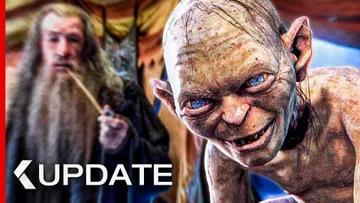Alongside "The Hunt for Gollum": Another "The Lord of the Rings" Movie in Development
What the movie will be about is still uncertain
News from Middle-earth: The announcement that a new "The Lord of the Rings" movie is planned with "The Hunt for Gollum" is sure to get some fans excited. But that's not all, because another film is currently in development!
In an interview with the industry magazine Empire, screenwriter Philippa Boyens initially made it clear that "The Hunt for Gollum" was not planned as a two-parter. This was originally hinted at in an interview with Sir Ian McKellen, the actor behind Gandalf. The misunderstanding arose because Warner Bros. was originally working on two different live-action films, only one of which will be "The Hunt for Gollum".
What the other film will be about is still a matter of speculation. The possibilities are almost endless. After all, Middle-earth offers plenty of opportunities to tell exciting stories. In the end, it all depends on which rights Warner Bros. can secure.

The "Lord of the Rings" Films: An Epic Journey Through Middle-Earth
J.R.R. Tolkien's masterpiece "The Lord of the Rings" has not only written literary history, but has also had a lasting impact on the fantasy genre in cinema. From the first cinematic adaptation in the 1970s to Peter Jackson's monumental trilogy and the "Hobbit" series, the adventures in Middle-earth have thrilled countless fans. Here we take a detailed look at the most important "The Lord of the Rings" film adaptations.
1. The Animated Film "The Lord of the Rings" (1978)
Before Peter Jackson brought the iconic film trilogy to life, the first attempt to bring Tolkien's epic to the big screen was made in 1978. The animated film "The Lord of the Rings", directed by Ralph Bakshi, was an ambitious project that covered the plot of the first part ("The Fellowship of the Ring") and half of the second part ("The Two Towers"). The film used a mixture of traditional animation and a technique called rotoscoping, where real actors were filmed and then painted over to give the characters a more realistic look.
Although the movie was praised for its visual innovation, it was not as successful in terms of content. The plot was severely shortened and the ending was left open as Bakshi was unable to realize a sequel. Nevertheless, the film enjoys a certain cult status today and laid the foundation for later adaptations.
2. Peter Jackson's "Lord of the Rings" Trilogy (2001-2003)
More than two decades after Bakshi's film, New Zealand director Peter Jackson ventured into an adaptation of Tolkien's work that would revolutionize the fantasy genre in cinema. "The Lord of the Rings" trilogy, consisting of "The Fellowship of the Ring" (2001), "The Two Towers" (2002) and "The Return of the King" (2003), became a global success and set new standards in film production.
"The Fellowship of the Ring" (2001)
The first part introduces the audience to the world of Middle-earth and tells of the creation of the One Ring, forged by Sauron, the Dark Lord. Frodo Baggins (played by Elijah Wood) is commissioned by the wizard Gandalf (played by Ian McKellen) to destroy the ring. Together with a group of companions – including the warrior Aragorn, the elf Legolas and the dwarf Gimli – Frodo embarks on a dangerous journey.
"The Fellowship" was celebrated for its breathtaking landscape shots, which were filmed in New Zealand, and the impressive special effects. The film was an instant success and laid the foundations for the huge success of the entire trilogy.
"The Two Towers" (2002)
The second part of the trilogy continues the story of the broken companions. As Frodo and Sam (played by Sean Astin) continue their journey to destroy the ring, they encounter the shady creature Gollum (portrayed by Andy Serkis using groundbreaking motion capture technology). The other companions fight against the armies of Sauron and Saruman.
The battle of Helm's Deep in particular is considered one of the most impressive highlights of the film and film history. Gollum's portrayal also set new standards in digital animation and contributed significantly to the movie's success.
"The Return of the King" (2003)
"The Return of the King" brought the epic story to an overwhelming conclusion. The battle for Middle-earth reaches its climax, and Frodo approaches Mount Doom to finally destroy the One Ring. The film is full of emotional and action-packed climaxes and was awarded a total of 11 Oscars, including the Oscar for Best Picture – an unprecedented achievement for a fantasy film.
With this conclusion, Peter Jackson completed his monumental trilogy, which was celebrated by critics and fans alike. The films are still considered masterpieces of cinema today.
3. The "Hobbit" Trilogy (2012-2014)
Following the success of "The Lord of the Rings" trilogy, Peter Jackson returned to Middle-earth a few years later to film "The Hobbit", Tolkien's prequel. Originally planned as a two-part film, the project was eventually split into a trilogy:
- "An Unexpected Journey" (2012)
- "The Desolation of Smaug" (2013)
- "The Battle of the Five Armies" (2014)
The plot revolves around the young hobbit Bilbo Baggins (played by Martin Freeman), who joins a group of dwarves to reclaim their lost kingdom of Erebor and defeat the dragon Smaug. Despite the familiar elements from "The Lord of the Rings" trilogy and the return of many beloved characters, such as Gandalf and Legolas, the films were not as well received as "The Lord of the Rings" trilogy. The main points of criticism were the overlong narrative style and the use of CGI.